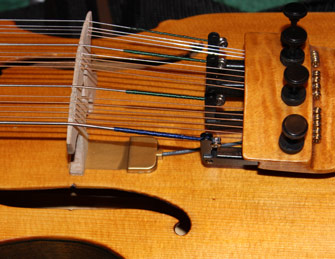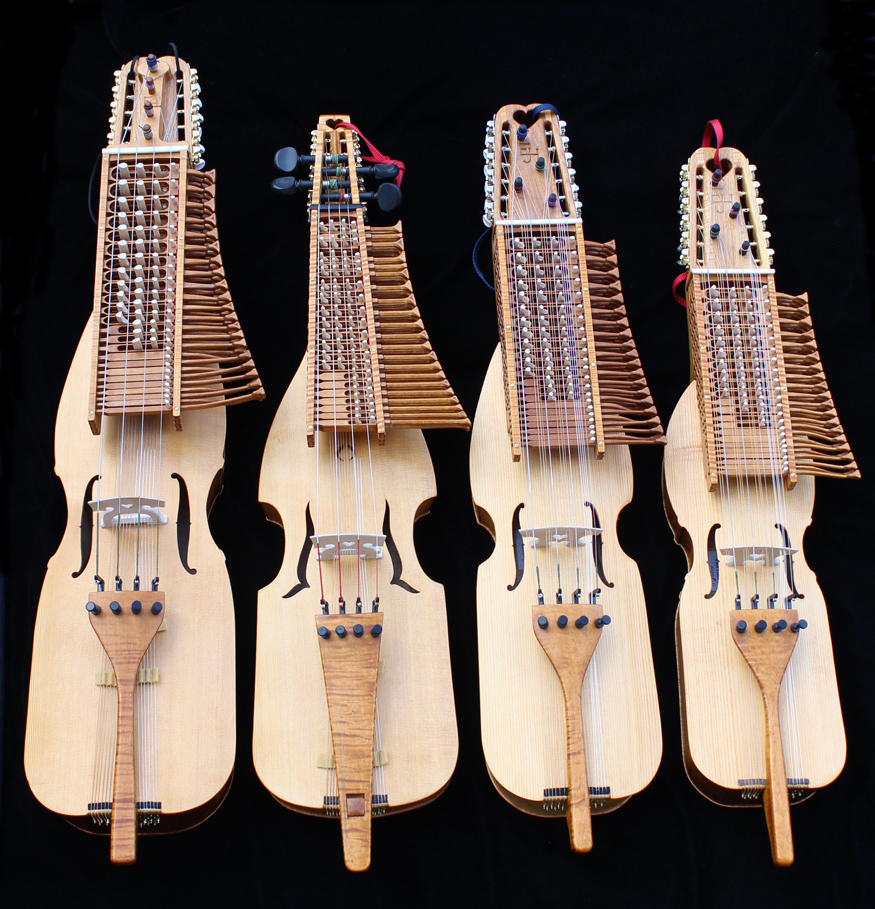Accessories
We provide a number of accessories for nyckelharpas. Here are general descriptions of the various items.
Amplification
There are basically two ways to amplify an acoustic instrument: the first is a dedicated microphone. This can either be on a stand or attached to the instrument. There are special microphones made to attach to instruments. A microphone works well in quieter settings.
The second method is a transducer pick-up that is attached directly to the instrument. This type of pick-up actually processes the vibrations of the instrument, which may need to be processed through a pre-amp. This type works well in loud performance venues.
There are pickups developed for various instruments that incorporate both microphones and the transducers.
 After a bit of research, Earl contacted K&K Sound. After a few back & forth e-mails with photos and back up information, they recommended an under-the-bridge transducer pick-up with a pre-amp. One was installed on harpa 10 (later removed) and it provides very good amplification.
After a bit of research, Earl contacted K&K Sound. After a few back & forth e-mails with photos and back up information, they recommended an under-the-bridge transducer pick-up with a pre-amp. One was installed on harpa 10 (later removed) and it provides very good amplification.
This is the Difinity System Pick-up on the K&K website:http://kksound.com/products/definity.php. We are authorized by K&K Sound and can install these pickups on nyckelharpas.
We are also now stocking the DPA 4099c microphone pick-up. This is the pick-up used by many of the professional Nyckelharpa players in Europe.
Other Accessories
We also carry the below items:
•Prim nyckelharpa strings - (see our separate page for strings)
•sympathetic strings - (see our separate page for strings)
•rosin - Nyckelharpa bows use violin rosin. Violin rosin is available at many music stores. We carry Hidersine violin rosin.
•screw drivers - A small screwdriver is needed for taking apart the key box. This is needed if you have sticking keys or other problems with the key box. Key boxes are put together with small screws. The key box is also attached to the neck using screws. The screws are commonly either slotted or Philips head screws. The sizes are medium to small sized.
If you travel by air, please make sure the metal portion of the screwdriver is small enough that it will not cause problems with airport security.
We are providing a small, multiple tip screwdriver with a range of small to medium slotted and Philips head tips. We are getting these from an auto parts store.
•pliers - A pair of pliers with smooth or padded jaws should be kept in the case. This is used to adjust the tuning of the tangents. The tangent is the small piece of wood that sticks up from the key and touches the string. The bottom of the tangent is a round post that is fit very snuggly in a hole in the key. The fit should be snug enough that it should be difficult to turn them with your fingertips. If the tangents are too loose, the keys will not stay tuned while playing.
You need a small tip pliers with some jaw padding. A couple wraps of tape is enough to pad the jaws.
Traveling: The TSA site indicates that pliers should be OK, but I have had them questioned at airport security. We now check pliers when traveling by air.
We supply a 5-inch slip pliers with the tip padded using a dipped plastic (designed for tool handles)
•peg wrenches - Most nyckelharpas use large wooden pegs for the four main playing strings. These pegs typically use a cello peg taper with a wood-on-wood friction fit. If they slip too easily, add chalk. If they stick too much add either soap with chalk or violin peg compound. They are frequently stiff enough to be hard to turn with just your fingers. A specialized wrench is often used. There are several different ways these can be made. The ones for nyckelharpas are usually made of wood.
Earl provides one of these wrenches with each instrument he builds.
•drill-bit peg winders (for the sympathetic strings) - When changing sympathetic strings, turning the thumb pegs on the guitar tuners by hand gets old really fast. To help with this, the guitar industry has come up with two basic versions of peg winders to help this go quicker. One is a hand crank peg winder and the other fits into a cordless screwdriver/drill. These are commonly available at music stores that sell guitars.
We carry both types of winders.
•digital tuners with clip-on microphone - For a nyckelharpa tuner we are recommending a Seiko model SAT 501 (or equivalent) with a clip on microphone. This is a digital tuner with a digital “cent” read out that allows you to tune very accurately. The clip–on microphone is typically attached to the bridge while tuning.
Several of the best nyckelharpa players we know use digital tuners with “cent” readouts.
About guitar tuners, both clip-on and stand-alone models:
The common guitar tuner is designed for use with fretted instruments. The frets are laid out as a best compromise for intonation of all of the strings at each fret. With this type of tuner, the notes will be within several cents +/-. These tuners typically do not get you intonation that is “spot on”.
With a nyckelharpa, the tangents (small posts that touch the strings) are mounted on a round post and can be turned to fine tune each key to exactly where you want it. The better the fine tuning and matching of the keys to the sympathetic strings, the better the resonation of the nyckelharpa.
Someone with a very good ear or “perfect pitch”, can accurately tune without a digital tuner until they get into a noisy environment, and then they need a good digital tuner.
•straps - The most common strap used with a nyckelharpa is a basic guitar strap. There are other types of straps available, such as the X-strap and Y-strap. The Jule Bauer nyckelharpa book has an entire section on different ways to attach and use straps along with different ways to hold the nyckelharpa while playing. We have basic guitar straps, guitar straps with a 2nd slider added, Y-straps and X-straps in stock.
If you use a basic guitar strap, get one that is very flexible. Strap pads also help with comfort. We carry fleece strap covers for the neck area.
There are several different locations and methods for attaching straps. This is somewhat dependent on what works to get the strap into a position that works well for the player.
The one caution we will give: The key box is held on with screws. Some people will tie a chord around the neck at the top of the body/bottom of the key box. If there is a gap at this location that allows for the chord to freely move, then there is space for the strap and this is OK. If this chord gets forced into a tight joint, it could damage the screw holes holding the key box on. If there is not space for a chord here, do not force one in. An attachment at the bottom of the neck/top of the body can be made with a guitar strap quick release.
At this time, we do accept PayPal for most items (not instruments). We do have order forms in pdf format which we can send if requested. Please contact us for more information.
(Note: any text that is a different color and underlined is a link to another web page. Clicking on it will take you there.)
(Page last updated on 12/23/2018)
